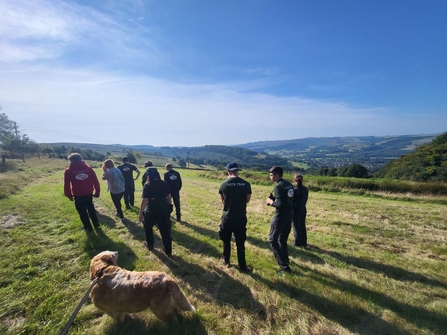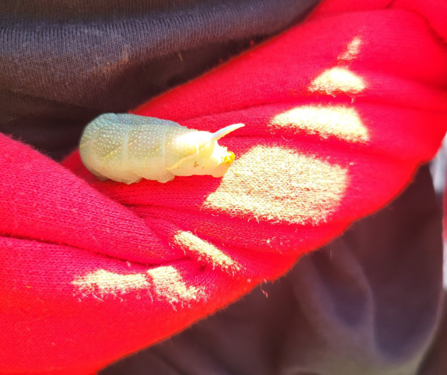Irreversible and unforgivable devastation caused by climate change beckons closer, therefore Keeping It Wild embarked for our neighboring county to connect with Hope Valley Climate Action on the front line. This passionate community group comprises members from many villages who are unwilling to ignore the currently catastrophic fate of their wild home in the Peak District. As a youth team who share these strong sentiments, we united with Scharlie to aid her efforts at Leveret Croft, Hathersage, and learn how wild gardening is resurrecting the space adjoined to her eco-home. Later, we followed the course of the Derwent guiding us towards Thornhill Carr, where we met David, who shared his knowledge of the nature reserve which is thriving under the autonomy of rewilding; where nature dictates its own future.
There is Hope for us all! When Keeping it Wild and Hope Valley Climate Action joined forces

View from Leveret Croft © Laura Bacon
As we traversed the testing landscape towards Hathersage, we became one with the eternally undulating greenery, an expansive panorama encompassing the gritstone phenomena of Stanage Edge. A popular climbing spot, this exposed rocky attraction is a symbol of resilience for the Hope Valley locals whose uphill battle against the forces of climate change will be met with equally unwavering determination so that the landscape remains scarred by its tectonic history and not wounded from the forces of changing weather. Taking action for nature can mitigate this reality, so Scharlie enlightened us with the wonders of her eco-home and wild garden. The four acres under her management may seem insignificant, insufficient to make a difference, lost in the vastness of our first National Park, but each and every field adds diversity for all who enjoy the valley’s views to indulge in, to be inspired by. The necessity of protection, for the endless swathes of land, could be visualised in a single glance, and evokes a palpable sense of urgency and the spirit of Hope.

No better place to stop for lunch © Laura Bacon
The Hope Valley Climate Action volunteers had rejuvenated a stretch of water into a freshwater frenzy and this top-notch transformation of the pond’s ecosystem was evident in the colonisation of aquatic plants. The air was scented by water mint, and Scharlie reminisced of her days wading in the water, preventing the total domination of irises. We saw the fruition of the group’s actions in front of us; sparkling Southern Darters soared above the shimmering surface, while froglets jumped and wriggled amongst the grasses, a meaningful species for the Hope Valley Climate Action team, who have witnessed a severe drop in the population of their amphibians in recent years, symptomatic of the scourge of tumultuous temperatures. Efficient management of water is not solely focused on wildlife, however, as the eco-house sources water sustainably from a local spring. A deeply embedded resourcefulness was profound at Leveret Croft, from the reused telegraph poles as beams in the house to the enormous compost heap, which supported the vegetable allotment and orchards in the far field. Alongside the courgettes and carrots were forageables like meadowsweet, abundant in the wildflower meadow. Yarrow, Devil’s-Bit Scabious and Purple Loosestrife were popular with the pollinators swarming this patch of the wild garden.
With the numbers, experience and youthful energy Keeping It Wild brought to the table, the day wouldn’t be without some practical conservation efforts in the woodland assisting to construct a frontier of brash. Branches of hawthorn and beech strewn across the meadow were removed and processed by the team to add to the colossal dead hedge, creating excellent hiding spaces for the small birds and mammals of Hathersage thus creating a greener border along the field boundary. In this wild garden, corridors for all living species were undoubtedly prioritized over human accessibility. Since taking over the land, the work of the Hope Valley Climate Action had also entailed the planting of hedgerows, adding food supplies, nesting spaces and perching spots for songbirds. Furthermore, a distinctly different dividing line had also been erected to vary the habitat, preserve history and maintain the quintessentially rural Peak District appearance. These famous dry stone walls of Derbyshire were mosaics of moss and lichen on the surface, and can shelter small birds and mammals deeper in the rocks, too. The garden’s biodiversity was evident throughout the day, and an infrequent encounter with a lime hawk moth caterpillar highlighted this before we departed.

Lime Hawk Moth Caterpillar © Laura Bacon
We then met with David of Hope Valley Climate Action who welcomed us to Thornhill Carr, a Derbyshire Wildlife Trust nature reserve where inspiration from locations such as the Knepp Estate has encouraged a unique approach to habitat development: rewilding. A strategy that aims to create a climate-resilient and self-sufficient habitat, meaning leaving the area undisturbed, to a degree where implementing the informative signage was debated. This is a place where human management is limited, and the environment is flourishing. The enormous metropolis of badgers on site attests to this, being the largest sett in Derbyshire. The community above ground is equally as complex, wildflower meadows like Betony are scattered across the steep sided banks and attract an array of butterflies. Similarly to the dereliction of walls and absence of hedgerows at Leveret Croft, historical negligence is also at fault for the eradication of keystone species, which could play a vital role in rewilding Derbyshire, hence grazing Highland cows are substituted for the void left by absent megaherbivores to control scrub and maintain the open glades. As nature reclaims Thornhill Carr, it may be possible to reintroduce some familiar faces, and one day Red Squirrels and Pine Martens may find their way back.
Our time with the Hope Valley Climate Action was an important experience for all involved. Scharlie’s property exhibited the range of sustainable measures possible for us to adopt, in order to adapt to the unpredictable world we live in. It proves that all aspects of people’s lives wield power and impact, across different backgrounds and generations. Both plots we toured are success stories in progress, and the partnership we formed will hopefully allow for future chances to learn and support efforts further. In the meantime, the midlands mission for Keeping it Wild is to take the principles of wilding into our own lives, and promote others to understand their own value in combating climate change and ecological crises through sustainable practices. Lastly, it will stay with us that management in new places will be different, but nonetheless absolutely appropriate for the aims of the area. We have found it is possible to unite against climate change as an entire region, and as individuals, by bonding with groups like the HVCA. To succeed, these conversations need to continue, and action needs to be taken.
Find out more
Get involved with Keeping it Wild and find out more about what they do.








